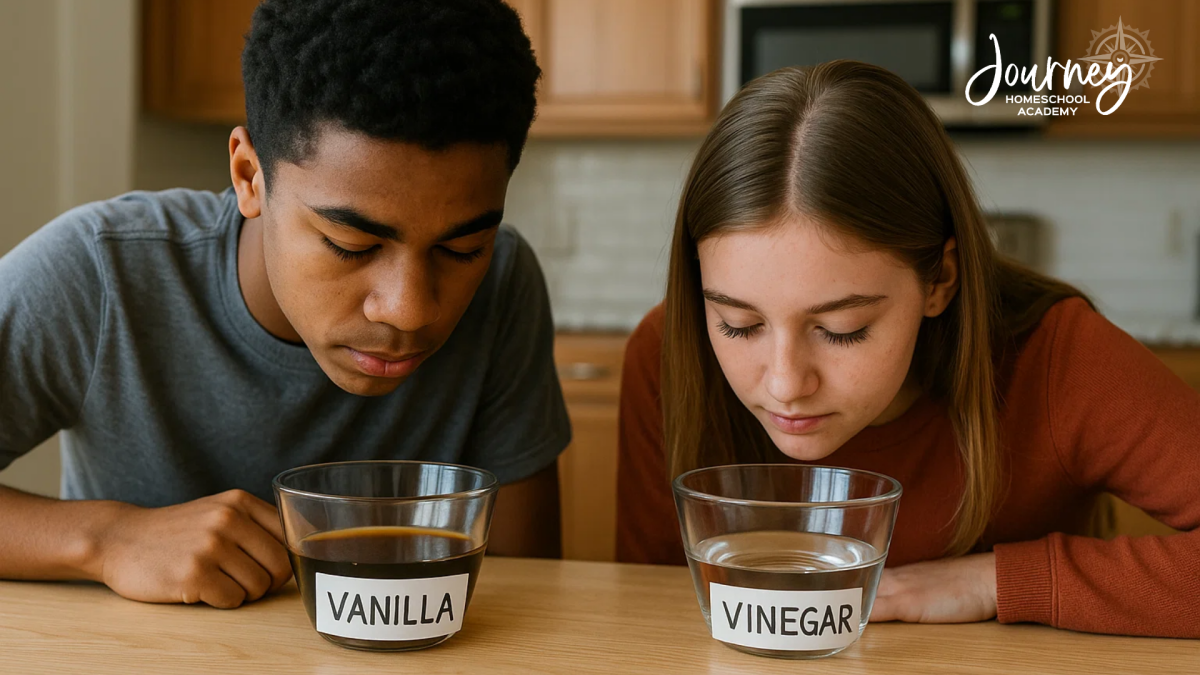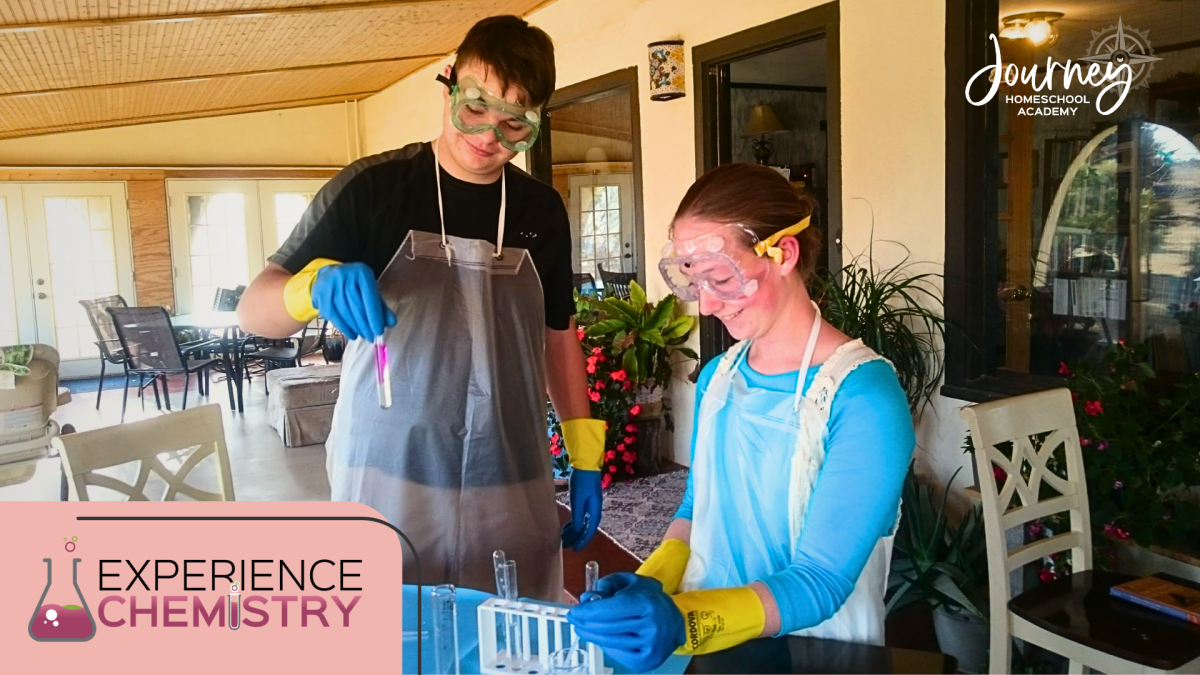If you have ever walked into your kitchen and smelled something mysterious, you have probably found yourself asking, “What is that smell?”
That exact question started a whole chemistry rabbit trail in our homeschool last week, right after someone forgot to throw away a science experiment… or maybe it was just the sponge.
As homeschool parents, we live for these real-life learning moments, the ones that spark curiosity and lead to discovery. So today, let’s turn one of the most familiar parts of daily life—our sense of smell—into a fascinating chemistry exploration your kids will never forget!
Why Things Smell the Way They Do
(and How to Turn It into a Homeschool Chemistry Lesson)

What’s Really Happening When You Smell Something
Before your student can say “eww!” or “yum,” their nose has already done a ton of chemistry.
Smells come from volatile molecules, which are tiny particles that escape into the air and drift into our noses. Inside our nasal passages are olfactory receptors, special chemical detectors that read these molecules like a lock reads a key. When a molecule fits a receptor just right, your brain gets the message: “That’s the smell of chocolate!” or “Warning, rotten eggs!”
In other words, every scent is chemistry in motion: molecules moving, binding, and triggering reactions faster than you can wrinkle your nose.
💡Homeschool tie-in: The next time your child opens a jar of peanut butter, have them imagine invisible molecules leaping into the air, racing toward their nose. It is the perfect example of matter in motion, a foundational chemistry concept made real.

Why Some Things Smell Sweet and Others Just Stink
Molecular Shape Matters
Every smell we experience comes from a molecule’s unique shape. Molecules with certain structures fit neatly into receptors that register as “pleasant,” while others trigger a “no thank you” response.
- Esters (found in fruits) often smell sweet, like bananas or strawberries.
- Sulfur compounds and amines (found in spoiled foods or fish) smell rotten or sour.
Even though we cannot see them, those atoms and bonds form chemical “recipes” that determine whether we say “mmm” or “yuck.”

Concentration and Temperature: Two Game-Changers
The same molecule can smell great or terrible depending on how much of it you are smelling.
Vanillin, the main compound in vanilla, smells wonderful in cookies, but if you sniff it in pure form, it can be overpowering. Meanwhile, that same butter flavoring you love on popcorn (butyric acid) smells absolutely awful on its own.
Temperature also plays a big role. Heat gives molecules energy to escape into the air, which is why warm cookies smell stronger than cold ones.
Try this homeschool experiment:
- Place a few drops of vanilla extract and vinegar in two bowls.
- Smell both at room temperature.
- Then gently warm them (do not boil).
Ask: Which smells stronger? Which one changed the most?
That is molecular motion, and it is chemistry in action.

Why Your Family Might Smell Things Differently
Here is a fun twist: not everyone smells the same way!
Genetics determines how many and what kind of olfactory receptors each person has. Some people cannot smell asparagus compounds, while others are highly sensitive to perfume.
💡Try this family activity: Gather small jars filled with things like mint, lemon, coffee, and vinegar. Have everyone rank them from best to worst. You might be surprised—Dad’s “refreshing mint” might be your teen’s “too strong!”
Bringing Chemistry to Life in Your Homeschool
Chemistry often feels abstract until you realize it is happening right under your nose, literally. The good news is you do not have to be a chemist to teach it.
Here are a few easy ways to make smell-based science part of your homeschool:
- Create “smell jars” with cotton balls soaked in safe scents such as lemon juice, essential oils, or vinegar.
- Compare scents before and after heating or chilling.
- Make “memory links” by associating a smell with a learning concept (for example, citrus equals acids).
If your student is ready to dig deeper, check out Experience Chemistry from Journey Homeschool Academy. It makes high school chemistry approachable, hands-on, and engaging.
Our family has loved how it combines rigorous science with clear video lessons, at-home labs, and a Christian worldview. Even if you have never felt confident teaching chemistry, this course helps your teen thrive and actually enjoy learning.

Faith and Science: God’s Design for Our Sense of Smell
Once you understand the chemistry of smell, it is hard not to see God’s hand in it. He could have made a colorless, scentless world, but instead, He filled it with aromas that stir emotion and memory.
Scripture is full of sensory imagery: the “pleasing aroma” of sacrifices in Leviticus, or Paul’s reminder that believers are “the fragrance of Christ” (2 Corinthians 2:15). God designed not just our sense of smell, but the chemistry that makes it work.
Every ester, every receptor, every memory tied to scent—each one whispers of His creativity and care.
The Sweet Smell of Learning
👃So, why do some things stink while others smell sweet?
Because chemistry, and God’s creation, is wonderfully complex. Every scent is a symphony of molecules, reactions, and brain signals working in perfect harmony.
Homeschooling gives us the unique gift of slowing down long enough to notice these things and to turn the everyday into an adventure in learning.
The next time your child asks, “Why does that smell funny?” lean in. That is not just curiosity; that is chemistry calling.
Explore more of God’s incredible world with Experience Chemistry, where students discover the science behind creation through engaging, hands-on lessons that make learning stick.

